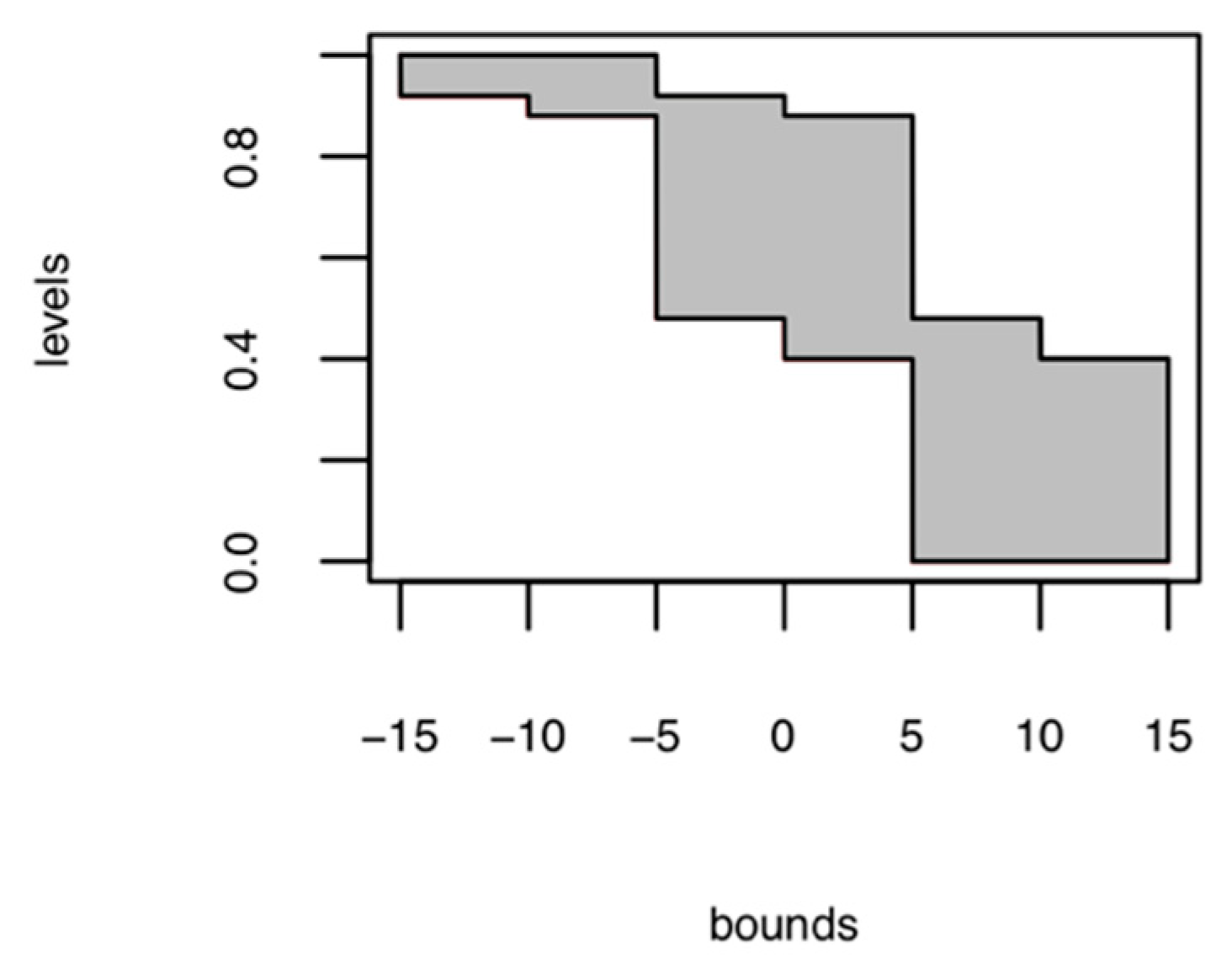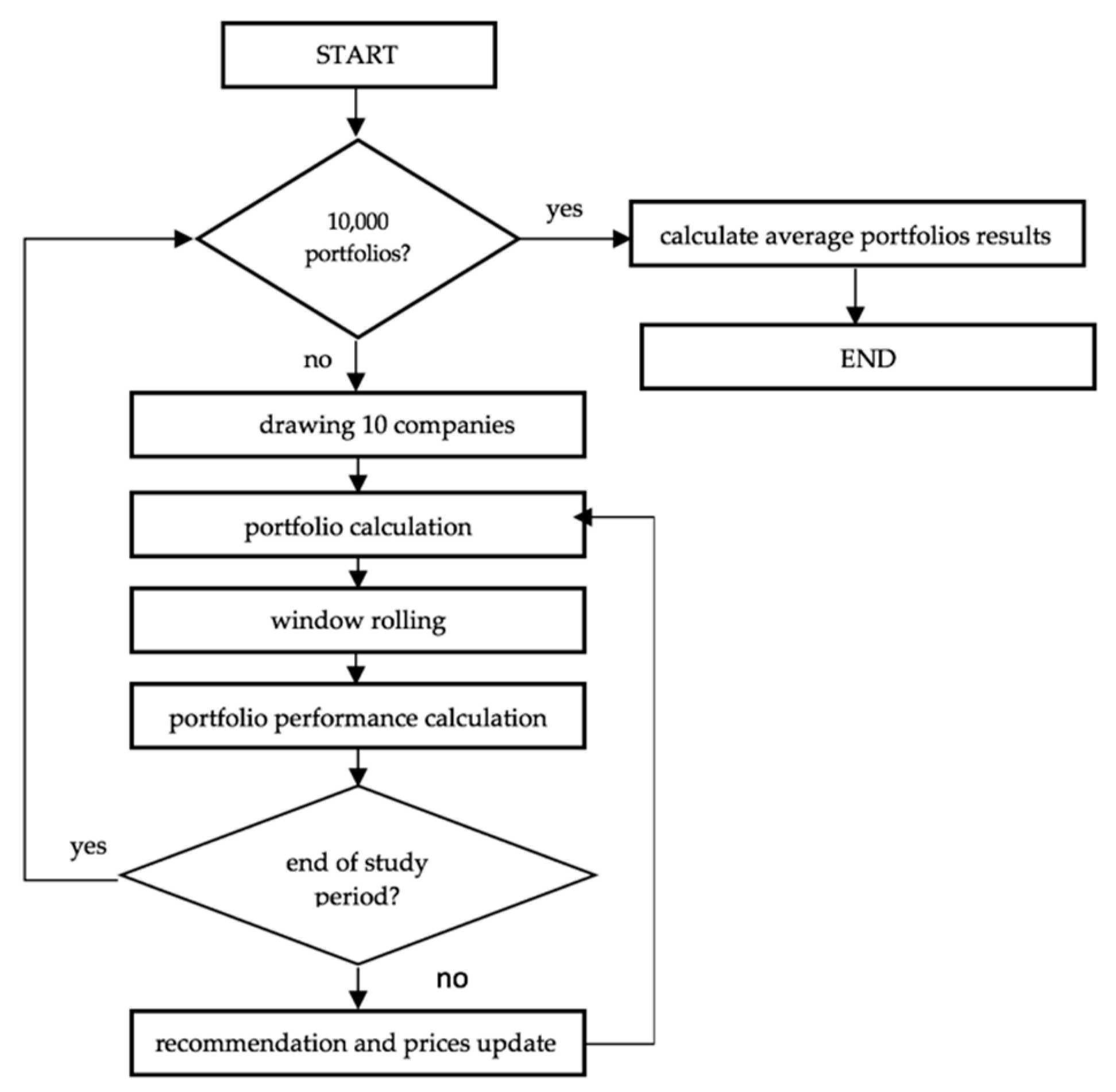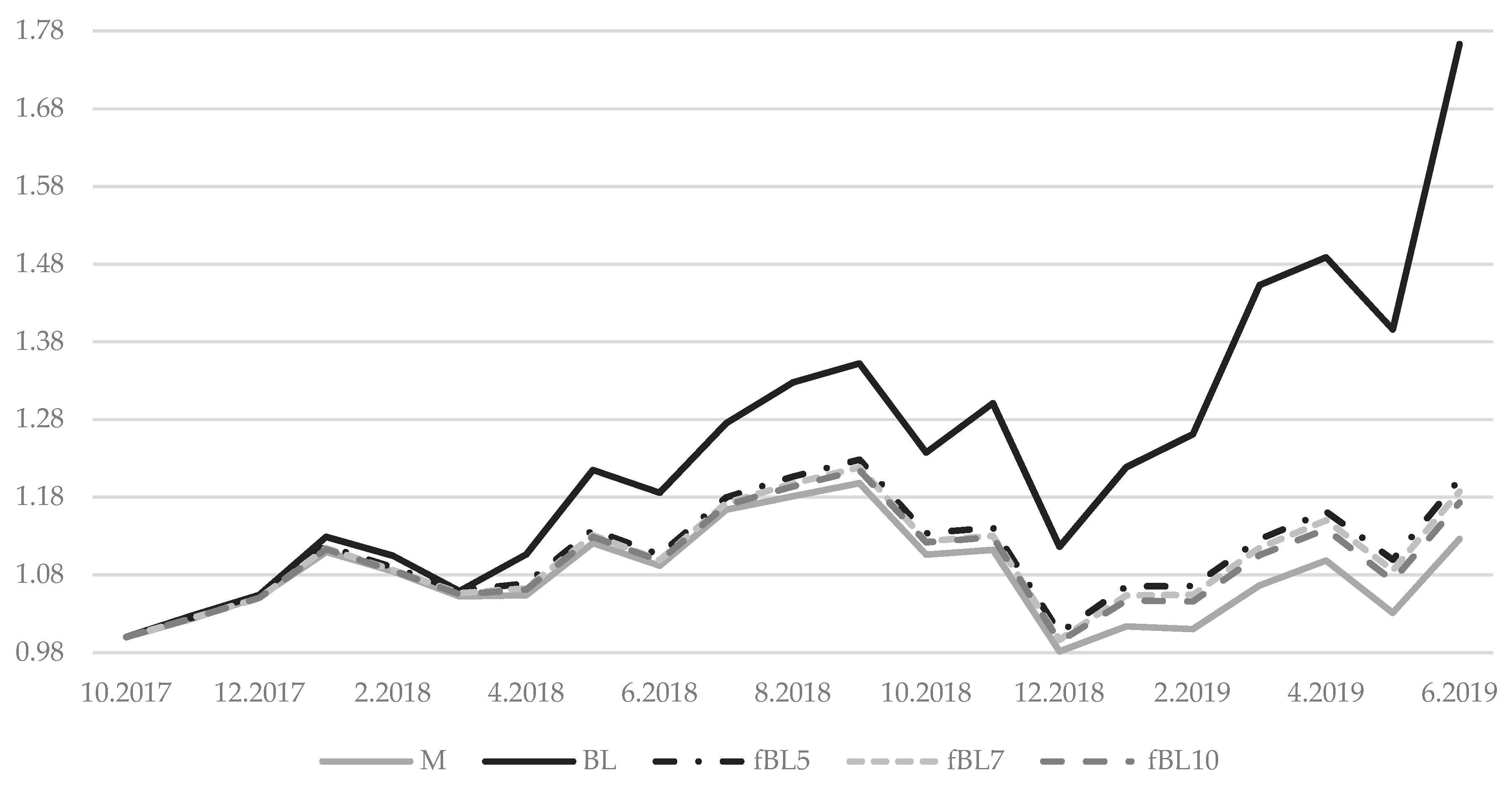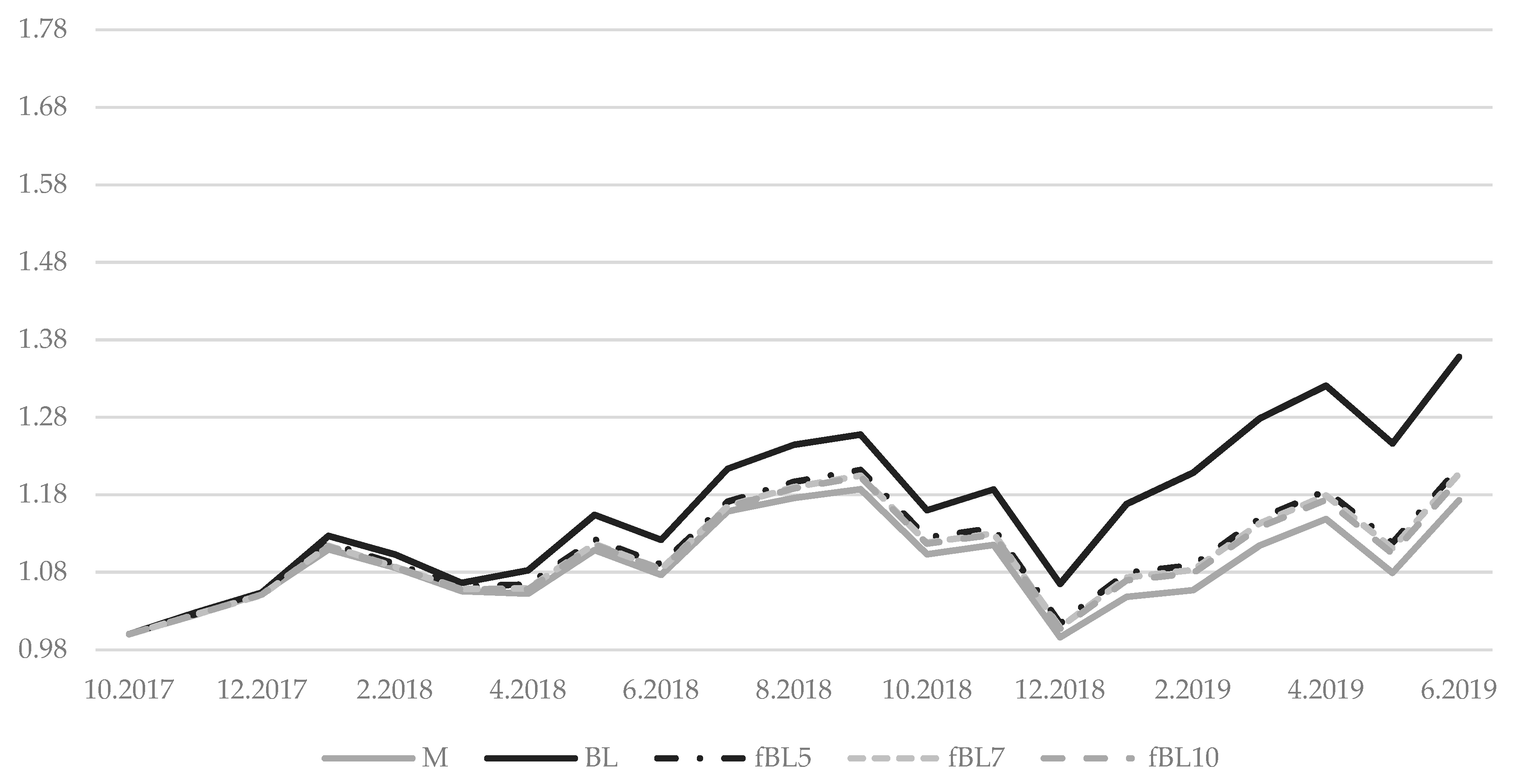Vague Expert Information/Recommendation in Portfolio Optimization-An Empirical Study
Abstract
1. Introduction
2. Preliminaries
3. Black–Litterman Model with Linguistic Views
- , a matrix of the asset weights within each view.
- , a vector of the interval with returns for each asset aggregated view.
- , a matrix of the covariance of the views. is diagonal as the views are required to be independent and uncorrelated. is known as confidence in the investor’s views. The -th diagonal element of is represented as .
- —vector of weights invested in each asset,
- —the new combined return vector,
- —new covariance matrix,
- —is the risk aversion coefficient.
4. Empirical Study
4.1. Method and Data Collection
- We draw 10 companies from the set of 29 corporations. It gives 20,030,010 possible combinations.
- The portfolio is created from drawn companies. Five approach is used:
- equilibrium model—CAPM (further labelled as ),
- standard BL model with aggregate opinions calculated as average weighted by the number of experts (further labeled as ),
- fuzzy BL model with aggregate opinions with interval width 5 p.p. (fBL5),
- fuzzy BL model with aggregate opinions with interval width 7 p.p. (fBL7),
- fuzzy BL model with aggregate opinions with interval width 10 p.p. (fBL10).
For each model, we have to regard 2 kinds of restrictions (with short selling and without short selling). This gives a total of 10 optimization tasks with regards to various models and to various restrictions. - We roll the window by 1 month.
- For the portfolios from step 2 we calculate the rate of return.
- We repeat steps 3 and 4 until the entire investment period runs.
- Steps 1–5 are repeated 10,000 times.
- We average the yields for each type of portfolio for single months
4.2. Results
5. Discussion
6. Conclusions
Author Contributions
Funding
Conflicts of Interest
References
- Black, F.; Litterman, R. Asset Allocation: Combining Investor Views with Market Equilibrium; Discussion paper; Goldman, Sachs & Co, 1999. [Google Scholar]
- Black, F.; Litterman, R. Global asset allocation with equities, bonds, and currencies. Fixed Income Res. 1999, 2, 218. [Google Scholar]
- Goetzmann, W.N.; Brown, S.J.; Gruber, M.J.; Elton, E. Modern Portfolio Theory and Investment Analysis; John Wiley & Sons: Hoboken, NJ, USA, 2014. [Google Scholar]
- Levy, H. The Capital Asset Pricing Model in the 21st Century: Analytical, Empirical, and Behavioral Perspectives; Cambridge University Press: Cambridge, MA, USA, 2011. [Google Scholar] [CrossRef]
- He, G.; Litterman, R. The intuition behind Black-Litterman model portfolios. SSRN 1999. [Google Scholar] [CrossRef]
- Litterman, B. Modern Investment Management: An Equilibrium Approach; John Wiley & Sons: Hoboken, NJ, USA, 2004; Volume 246. [Google Scholar]
- Idzorek, T. A step-By-Step guide to the Black-Litterman model: Incorporating user-Specified confidence levels. In Forecasting Expected Returns in the Financial Markets; Satchell, S., Ed.; Academic Press: Cambridge, MA, USA, 2007; pp. 17–38. [Google Scholar]
- Satchell, S.; Scowcroft, A. A demystification of the Black–Litterman model: Managing quantitative and traditional portfolio construction. J. Asset Manag. 2000, 1, 138–150. [Google Scholar] [CrossRef]
- Walters, J. The Black-Litterman Model in Detail. SSRN 2014. [Google Scholar] [CrossRef]
- Meucci, A. Beyond Black-Litterman: Views on non-Normal markets. Risk 2006, 19, 87–92. [Google Scholar] [CrossRef]
- Giacometti, R.; Bertocchi, M.; Rachev, S.T.; Fabozzi, F.J. Stable distributions in the Black-Litterman approach to asset allocation. Quant. Financ. 2007, 7, 423–433. [Google Scholar] [CrossRef]
- Beach, S.L.; Orlov, A.G. An application of the Black–Litterman model with EGARCH-M-derived views for international portfolio management. Financ. Mark. Portf. Manag. 2007, 21, 147–166. [Google Scholar] [CrossRef]
- Bertsimas, D.; Gupta, V.; Paschalidis, I.C. Inverse optimization: A new perspective on the Black-Litterman model. Oper. Res. 2012, 60, 1389–1403. [Google Scholar] [CrossRef]
- Lawrence, K.D.; Pai, D.R.; Klimberg, R.K.; Lawrence, S.M. A fuzzy programming approach to financial portfolio model. In Financial Modeling Applications and Data Envelopment Applications; Lawrence, K., Kleinman, G., Eds.; Emerald Group Publishing Limited: Bingley, UK, 2009; pp. 53–59. [Google Scholar] [CrossRef]
- Gharakhani, M.; Sadjadi, S. A fuzzy compromise programming approach for the Black-Litterman portfolio selection model. Decis. Sci. Lett. 2013, 2, 11–22. [Google Scholar] [CrossRef]
- Bartkowiak, M.; Rutkowska, A. Black-Litterman Model with Multiple Experts’ Linguistic Views. In International Conference on Soft Methods in Probability and Statistics; Ferraro, M.B., Giordani, P., Vantaggi, B., Gagolewski, M., Gil, M.A., Grzegorzewski, P., Hryniewicz, O., Eds.; Springer, Cham: Berlin/Heidelberg, Germany, 2016; pp. 35–43. [Google Scholar] [CrossRef]
- Rutkowska, A.; Bartkowiak, M. Experton approach to vague information in portfolio selection problem with many views. In 2019 Conference of the International Fuzzy Systems Association and the European Society for Fuzzy Logic and Technology (EUSFLAT 2019); Atlantis Press: Paris, France, 2019; pp. 142–149. [Google Scholar] [CrossRef]
- Fang, Y.; Bo, L.; Zhao, D.; Wang, S. Fuzzy views on Black-Litterman portfolio selection model. J. Syst. Sci. Complex. 2018, 31, 975–987. [Google Scholar] [CrossRef]
- Kaufmann, A. Theory of expertons and fuzzy logic. Fuzzy Sets Syst. 1988, 28, 295–304. [Google Scholar] [CrossRef]
- Couturier, A.; Fioleau, B. Expertons and management decision-Making criteria interdependence and implications valuation. Fuzzy Econ. Rev. 1996, 1, 31–46. [Google Scholar] [CrossRef]
- Nait-Said, R.; Loukia, H. Applying the concept of experton to fuzzy mental workload modeling. Fuzzy Econ. Rev. 2003, 8, 39–63. [Google Scholar] [CrossRef]
- Merigó, J.M.; Lafuente, A.M.G.; Barcellos, L. Uncertain induced generalized aggregation operators and its application in the theory of expertons. Fuzzy Econ. Rev. 2010, 15, 25–43. [Google Scholar] [CrossRef]
- Merigó, J.M.; Casanovas, M.; Yang, J.B. Group decision making with expertons and uncertain generalized probabilistic weighted aggregation operators. Eur. J. Oper. Res. 2014, 235, 215–224. [Google Scholar] [CrossRef]
- Jaile-Benitez, J.M.; Ferrer-Comalat, J.C.; Linares-Mustarós, S. Determining the influence variables in the pork price, based on expert systems. In Scientific Methods for the Treatment of Uncertainty in Social Sciences; Gil-Aluja, J., Terceño-Gómez, A., Ferrer-Comalat, J.C., Merigó-Lindahl, J., Linares-Mustarós, S., Eds.; Springer, Cham: Berlin/Heidelberg, Germany, 2015; pp. 81–92. [Google Scholar] [CrossRef]
- Santos Caballero, A.; Gil Lafuente, J. The new Fuzzy SWOT: Empirical application with expertons. ESIC Mark. 2017, 48, 121–141. [Google Scholar] [CrossRef]
- Sirbiladze, G.; Khutsishvili, I.; Ghvaberidze, B. Multistage decision-Making fuzzy methodology for optimal investments based on experts’ evaluations. Eur. J. Oper. Res. 2014, 232, 169–177. [Google Scholar] [CrossRef]





| Sector | |||||
| Financials | Information Technology | Health Care | Consumer Discretionary | ||
| Aflac Bank of America Credit Acceptance JP Morgan Morgan Stanley | Apple IBM Microsoft Visa | Bristol-Myers Eli Lilly Johnson & Johnson Merck Pfizer | Amazon Ford Gap General Motors Tesla The Home Depot Nike | ||
| Sector | |||||
| Consumer Staples | Industrials | Energy | Communication Services | Materials | |
| Archer Daniels Procter & Gamble Walmart | Boeing Lockheed Martin | Exxon | Alphabet | Southern Copper | |
| Width | Labels | ||||
|---|---|---|---|---|---|
| Sell | Underweight | Hold | Overweight | Buy | |
| 5 | |||||
| 7 | |||||
| 10 | |||||
| with Short Sale | ||||
| M | BL | fBL5 | fBL7 | fBL10 |
| 48.87% | 244.03% | 49.22% | 49.05% | 48.25% |
| without Short Sale | ||||
| M | BL | fBL5 | fBL7 | fBL10 |
| 36.97% | 36.69% | 39.00% | 38.87% | 38.21% |
| with Short Sale | ||||
| M | BL | fBL5 | fBL7 | fBL10 |
| 7.74% | 22.19% | 8.14% | 7.93% | 7.81% |
| without Short Sale | ||||
| M | BL | fBL5 | fBL7 | fBL10 |
| 6.79% | 10.72% | 7.42% | 7.28% | 7.15% |
| Percentage of the Best Portfolios | Percentage of the Worst Portfolios | ||||
|---|---|---|---|---|---|
| with Short Sale | |||||
| M | BL | fBL5 | M | BL | fBL5 |
| 20% | 58% | 22% | 44% | 31% | 25% |
| M | BL | fBL7 | M | BL | fBL7 |
| 20% | 59% | 21% | 44% | 31% | 24% |
| M | BL | fBL10 | M | BL | fBL10 |
| 21% | 60% | 18% | 44% | 32% | 24% |
| without Short Sale | |||||
| M | BL | fBL5 | M | BL | fBL5 |
| 21% | 57% | 23% | 45% | 27% | 29% |
| M | BL | fBL7 | M | BL | fBL7 |
| 20% | 59% | 21% | 45% | 28% | 28% |
| M | BL | fBL10 | M | BL | fBL10 |
| 20% | 60% | 20% | 44% | 29% | 28% |
© 2020 by the authors. Licensee MDPI, Basel, Switzerland. This article is an open access article distributed under the terms and conditions of the Creative Commons Attribution (CC BY) license (http://creativecommons.org/licenses/by/4.0/).
Share and Cite
Bartkowiak, M.; Rutkowska, A. Vague Expert Information/Recommendation in Portfolio Optimization-An Empirical Study. Axioms 2020, 9, 38. https://doi.org/10.3390/axioms9020038
Bartkowiak M, Rutkowska A. Vague Expert Information/Recommendation in Portfolio Optimization-An Empirical Study. Axioms. 2020; 9(2):38. https://doi.org/10.3390/axioms9020038
Chicago/Turabian StyleBartkowiak, Marcin, and Aleksandra Rutkowska. 2020. "Vague Expert Information/Recommendation in Portfolio Optimization-An Empirical Study" Axioms 9, no. 2: 38. https://doi.org/10.3390/axioms9020038
APA StyleBartkowiak, M., & Rutkowska, A. (2020). Vague Expert Information/Recommendation in Portfolio Optimization-An Empirical Study. Axioms, 9(2), 38. https://doi.org/10.3390/axioms9020038





